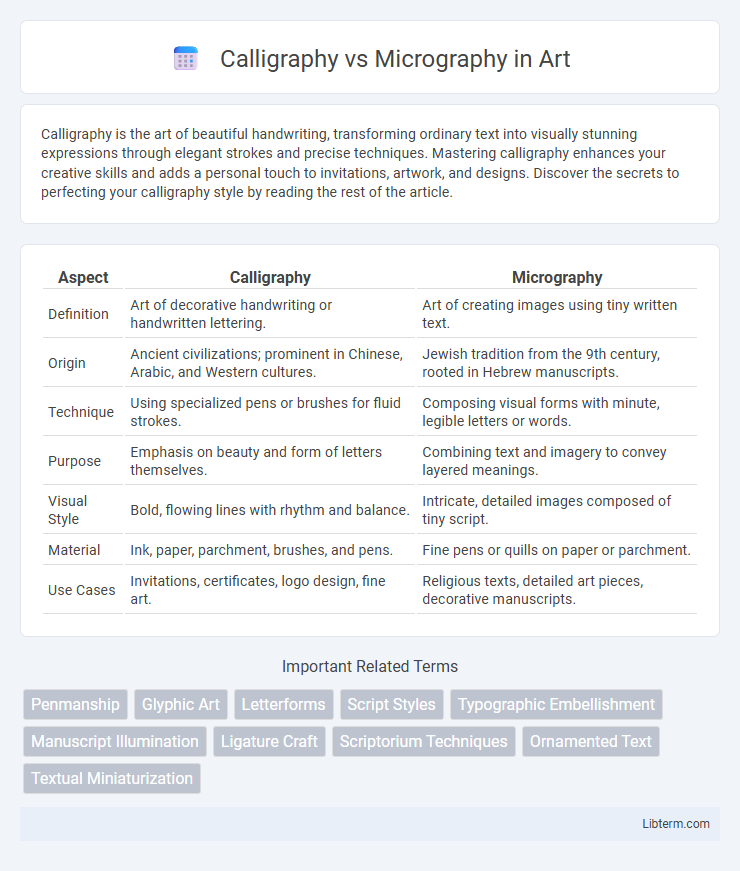Calligraphy is the art of beautiful handwriting, transforming ordinary text into visually stunning expressions through elegant strokes and precise techniques. Mastering calligraphy enhances your creative skills and adds a personal touch to invitations, artwork, and designs. Discover the secrets to perfecting your calligraphy style by reading the rest of the article.
Table of Comparison
| Aspect | Calligraphy | Micrography |
|---|---|---|
| Definition | Art of decorative handwriting or handwritten lettering. | Art of creating images using tiny written text. |
| Origin | Ancient civilizations; prominent in Chinese, Arabic, and Western cultures. | Jewish tradition from the 9th century, rooted in Hebrew manuscripts. |
| Technique | Using specialized pens or brushes for fluid strokes. | Composing visual forms with minute, legible letters or words. |
| Purpose | Emphasis on beauty and form of letters themselves. | Combining text and imagery to convey layered meanings. |
| Visual Style | Bold, flowing lines with rhythm and balance. | Intricate, detailed images composed of tiny script. |
| Material | Ink, paper, parchment, brushes, and pens. | Fine pens or quills on paper or parchment. |
| Use Cases | Invitations, certificates, logo design, fine art. | Religious texts, detailed art pieces, decorative manuscripts. |
Introduction to Calligraphy and Micrography
Calligraphy is the art of beautiful, stylized handwriting created with specialized pens or brushes, emphasizing fluid strokes and artistic expression. Micrography, a unique form of Jewish visual art, involves composing intricate images using minute, precisely arranged Hebrew text, blending calligraphic skill with detailed micro-writing. Both practices showcase mastery of letterforms but differ in their primary focus--calligraphy centers on aesthetic script, while micrography integrates textual content to form detailed imagery.
Historical Origins and Evolution
Calligraphy, originating in ancient civilizations like Egypt and China, evolved as a formal artistic writing style often linked to religious and cultural documentation, emphasizing fluidity and aesthetic harmony of individual characters. Micrography, developed primarily within Jewish art in the Middle Ages, utilizes tiny Hebrew letters to create intricate images or patterns, blending text and visual art for religious manuscripts and decorative purposes. Both forms reflect a fusion of textual meaning and visual beauty, with calligraphy focusing on expressive script styles while micrography incorporates detailed miniaturized text as a graphic element.
Defining Features and Techniques
Calligraphy is characterized by fluid, expressive strokes created with specialized tools such as broad-edge pens or brushes, emphasizing the artistic formation of large, elegant letters. Micrography, originating from Jewish art traditions, involves composing tiny, precise text to form intricate images or designs, blending written language and visual art at a microscopic level. Both techniques showcase mastery in control and detail, with calligraphy focusing on stylistic letterforms and micrography on textual imagery integration.
Primary Tools and Materials Used
Calligraphy primarily utilizes brush pens, nib pens, and ink on smooth paper or parchment, emphasizing fluid strokes and varying line thickness. Micrography employs fine-tipped pens, often micron or technical pens, on durable, high-quality paper optimized for detailed, miniature text arrangements. Both art forms require precision tools, but calligraphy focuses on dynamic brush and ink combinations, while micrography demands ultra-fine pens for intricate text composition.
Artistic Styles and Aesthetics
Calligraphy emphasizes fluid, sweeping strokes that highlight individual letterforms with expressive, ornamental qualities, often using ink and brush techniques to create visually dynamic compositions. Micrography, rooted in Jewish tradition, transforms tiny, meticulously arranged Hebrew text into intricate, geometric or figurative shapes, blending textual precision with visual art. Both styles merge linguistic and aesthetic elements, yet calligraphy prioritizes expressive line work while micrography focuses on detailed textual patterning for decorative impact.
Cultural and Religious Significance
Calligraphy holds profound cultural and religious significance in Islamic and East Asian traditions, often used to convey sacred texts with artistic elegance. Micrography, a unique Jewish art form, transforms biblical verses into intricate designs, emphasizing devotion and reverence through text-based imagery. Both art forms serve as spiritual expressions, preserving religious heritage while bridging visual beauty and textual meaning.
Common Applications and Uses
Calligraphy and micrography serve distinct yet complementary purposes in art and communication; calligraphy is widely used for decorative writing in invitations, certificates, and branded logos, emphasizing aesthetic letterforms and fluid strokes. Micrography, a Jewish art form, is primarily employed in religious texts and intricate artworks, utilizing tiny text to create larger images or designs, combining textual meaning with visual impact. Both practices enhance the visual appeal of written content but differ in scale and technique, with calligraphy focusing on expressive, larger script and micrography on meticulous, miniature text arrangements.
Skillsets Required for Each Art Form
Calligraphy demands precise hand control, mastery of various pen strokes, and an understanding of typography to create fluid and expressive letterforms. Micrography requires exceptional patience, fine motor skills, and the ability to write legible miniature text that forms intricate designs. Both art forms benefit from a strong sense of spatial awareness and artistic composition to achieve visually appealing results.
Contemporary Trends and Innovations
Contemporary calligraphy embraces digital tools and mixed media, blending traditional brush strokes with graphic design software to create dynamic and personalized artwork. Micrography innovates by integrating microscopic handwritten text into larger images, often utilizing advanced printing techniques and digital magnification to enhance visual complexity. Both art forms increasingly intersect with augmented reality, allowing viewers to engage interactively with the intricate details of script and imagery.
Choosing Between Calligraphy and Micrography
Choosing between calligraphy and micrography depends on the desired artistic effect and project scale; calligraphy emphasizes elegant, flowing strokes with broad tools, ideal for expressive and decorative lettering, while micrography uses tiny text to form images, offering intricate detail and conceptual depth. Calligraphy suits large-scale invitations, signage, and formal documents, whereas micrography excels in creating unique visual narratives or detailed artwork using text as a medium. Consider the purpose, readability, and viewer engagement when selecting the technique that best aligns with your creative goals.
Calligraphy Infographic

 libterm.com
libterm.com